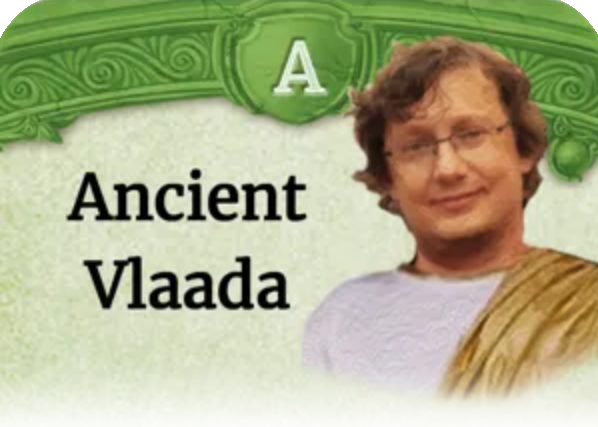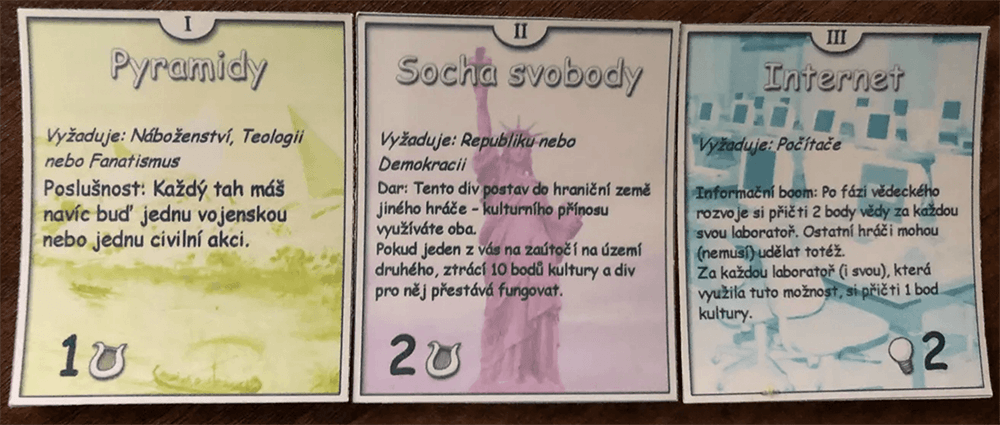
Through the Designer’s Notes, Part 2 – Vlaada Chvatil
 In my last post, I wrote about how the leaders snuck out of one of my older prototypes in Through the Ages. You’re probably wondering about the wonders, too. But before I go into that, I owe you one more explanation.
In my last post, I wrote about how the leaders snuck out of one of my older prototypes in Through the Ages. You’re probably wondering about the wonders, too. But before I go into that, I owe you one more explanation.
Who Leads the Nation
Even if you accept the random approach to choosing leaders that I described earlier, you’re probably still wondering: why the hell I thought Aristotle, James Cook, or Sid Meier were leaders of a nation? Well, I didn’t. In my Czech prototype they were called “osobnosti”, which means “personalities” or “great persons”. Their map texts were not meant to be the effects of their leadership, but rather the influence and legacy that affected the entire nation for centuries. The nation had only one leader, timeless and preeminent – you.
When Jason, our translator, translated it as “leader,” I was not satisfied with that. He argued that calling them “leaders” was much simpler and easier to understand than “great people” and people would get used to it. I wasn’t sure, but I reluctantly agreed. As a memento, we still call them “osobnosti” in all Czech versions of the game.
While writing the manual for the new version, I stumbled over it again. I tried to make clear how it was meant (in the section on leaders it is written: “A leader is a great historical figure whom a player chooses as the spiritual leader of his civilization. The legacy of which confers special abilities and benefits.”)
But artificial drum-beating doesn’t work well. They are called leaders, therefore they are considered leaders. We even show the current leader as a player avatar in the digital version of the game (and this is usually what you have in mind when you remember your teammates), and when people play the game, they seem to accept that a nation is led by Shakespeare. At least I got used to it – Jason was right.🙂
And Those Wonders
As you can guess, this old game also had wonders; because while having great personalities is optional in a civilization-themed game, wonders are simply a must :). Although many of the wonders from that game also appear in Through the Ages, the variations in selection were much greater in this case. I could say it was because the wonders worked very differently – they were only from three ages, they depended on certain technologies, they were chosen and built in different ways, they belonged to a certain area, etc – but to be honest, the fact that I only had googled background images and no hand-drawn illustrations for the original wonders made the decision to change them a lot easier.🙂
Some remained for obvious reasons – who would make a list of wonders without the pyramids or the Great Wall of China? But there were also some less typical ones that were part of the original selection.
One of those I was proud of at the time was the Internet. You might ask: Why, the Internet is a typical wonder represented in most civilization games, isn’t it? But at the time I was designing this game, Civilization III, in which the Internet first appeared, hadn’t even been released yet. And I said to myself, hey, is there anything that has changed humanity more in the last century than this instant access to information and the low-cost ability to provide content to others? Sid Meier should incorporate the Internet as a miracle into his games. I’m definitely going to do it. 🙂
When I see what the Internet and social media are doing to people today, I’m not that excited, but still, the Internet is influencing the world more than anything else. It doesn’t have to be all positive. That brings me to fast food chains, another miracle that came out of the first game. This strange “wonder” might make some people question my values :). But no, I’m not a regular Mc-Taco-King-whatever consumer. The idea was to show that culture points reflect how much they impact the world, and that it doesn’t have to be objectively positive. You can spread your culture through great artists, through your swords, or even through hamburgers. So I included fast food in Through the Ages as well, as a symbol of globalization that certainly influences the world a lot.
By the way, Zeitalter III-Wunder were more interesting in that old game, they had some strong and cool permanent effects. But that just didn’t work well. You can’t balance effects well if you don’t know if they’re in play for five turns or just one. Changing them to just “give a huge amount of culture when completed” was a good solution. I lost some of the thematic variability, but now completing an Zeitalter III-Wunders is the real highlight of the game, while considering whether a wonder still “pays off or not” was not. In the expansion I played around a bit more and all the wonders are more interactive, but I still kept in mind that their main effect should be a high culture value (in the case of Manhattan Project, it may be culture gained from a war). 🙂
Ah, I was just looking through those old maps and found something I had already forgotten. The Statue of Liberty was also a wonder in that old game (in Through the Ages it was added in the expansion). However, the original effect was different – you had to build it on another player’s territory, thus both got some culture, but if you attacked each other, both suffered a huge culture penalty. Sound familiar? Yes, this wonder was the first pact in the game.

Originally published on blog.czechgames.com,
on 21th of May 2020.

